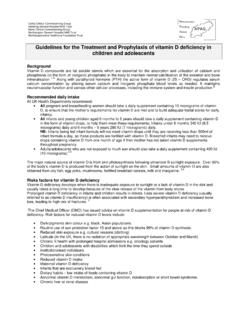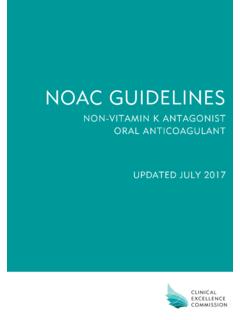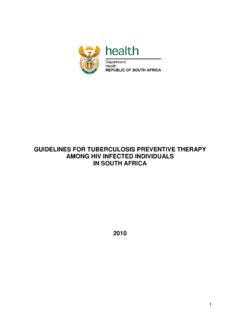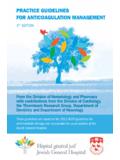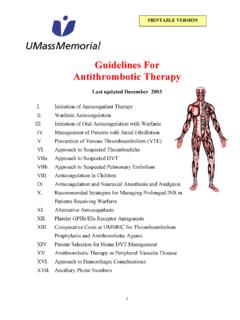Transcription of Anticoagulants and antiplatelet drugs - jaiser.com
1 1/8 Anticoagulants and antiplatelet drugs Classification Anticoagulants Parenteral Heparin UFH LMWH Enoxaparin Tinzaparin Dalteparin Certoparin Heparinoids Danaparoid Hirudins Lepirudin Bivalirudin Pentasaccharide Idraparinux Fondaparinux Oral Warfarin Acenocoumarole (= nicoumalone) Phenindione Factor Xa inhibitors Rivaroxaban Thrombin inhibitors Ximelagatran (Exanta ) Dabigatran (Pradaxa )
2 antiplatelet drugs Aspirin Dipyridamole Thienopyridines Clopidogrel Ticlopidine GP IIb/IIIa antagonists Abciximab Eptafibatide Tirofiban Thrombolytics For acute arterial thromboembolism see IHD. Generally speaking! Anticoagulants o Esp. useful in prevention/treatment of venous occlusion o More effective antiplatelet drugs o Esp. useful in arterial occlusions (?because arterial thrombi are platelet-rich) o Less likely to cause haemorrhage Parenteral Anticoagulants UFH Naturally occurring mammalian mucopolysaccharides.
3 Molecular weight ~30kD (mean 12kD) 2/8 Indications Therapeutic (because of rapid onset of action) DVT/PE ACS Prophylactic DVT/PE prophylaxis o Surgery, esp. orthopaedics o Immobile patients Extracorporeal circuits (cardiopulmonary bypass, haemodialysis) Mechanism of action Pentasaccharide sequence: binds to natural antithrombin-III and accelerates breakdown of factor Xa 1000-fold. 18+ saccharide sequence: also accelerates factor IIa breakdown by similar mechanism LMWHs have shorter chain lengths and accelerate factor Xa breakdown more (ca. 3-fold) Dosing prophylaxis Low dose 5,000 units SC 8 or 12 hourly Monitoring not required (APTT largely unaffected) Treatment High dose o Loading bolus (5,000U) plus continuous infusion (30,000-40,000U over 24 hours, or 25U/kg/h) Continue until fully anticoagulated with warfarin Monitoring APTT ratio (intrinsic + common systems) at 4-6h after starting o Repeat every 4-6h with dose adjustment until APTT ratio is times control o If stopped, effect subsides in 2-3h Adverse effects Bleeding o Reversal: 1mg protamine for 100IU UFH if within 15min of heparin, less later HIT (2-3%) o Must monitor platelets from day 5 o UFH>>LMWH Osteoporosis if more than 4 months treatment o Esp.
4 In pregnant women who had to swap warfarin for heparin 3/8 Contraindications As NSAIDs, plus previous HIT LMWH LMWHs are produced by chemical ( enoxaparin) or enzymatic ( tinzaparin) depolymerisation of UFH Molecular weight 2-10kD (mean 5kD) LMWH vs. UFH - theory The biological activity of heparins is related to fractional molecular weight: < mainly anti-Xa activity > both anti-Xa and anti-IIa activity anti-IIa activity is dependent on chain length Pros Shorter chains cleared more slowly: UFH t1/2 = 2-3h, enoxaparin t1/2 = ca. 4h (this is a con in renal failure) Reduced binding to plasma proteins (which compete with and reduce inhibition of antithrombin) Not bound by PF4 from activated platelets Bioavailability of fractionated heparins from SC administration is considerably higher more predictable anticoagulant activity for LMWHs; no need for IV infusion (more convenient for patient and saves on nursing time but note prophylactic heparin can be given SC, too) and no need to monitor APTT (saves on lab time and costs) Lower incidence of HIT Lower incidence of osteoporosis Hope of lower incidence of bleeding at equivalent antithrombotic dose has not borne out Cons Cannot monitor APTT need factor X ratio (expensive.)
5 No need if average body mass, n crea, short duration of use) Incompletely reversed by protamine (just 20%) Expensive (10x) LMWH vs. UFH - practice Fractionated heparins are taking over from unfractionated heparins for most of the accepted indications. Superior efficacy proven for Treatment of DVT/PE ACS (ESSENCE trial) Orthopaedic lower limb surgery But also used in DVT/PE prophylaxis Extra-corporeal circuits (unlicensed indication) Note The different methods of preparation of LMWHs mean that there are important differences in molecular weight distribution. It is not possible to extrapolate trial data between different preparations. Only enoxaparin is now widely used Heparinoids Lower degree of sulfation Possible indications Available on named-patient basis DVT prophylaxis in general and orthopaedic surgery 4/8 Severe HIT if no evidence of cross-reactivity (rare: 10%) Hirudins Specific thrombin inhibitors Factor IIa inhibitors Don t bind plasma proteins or PF4 Don t rely on AT3 No specific antidote Indication Lepirudin: licensed for HIT type II Pentasaccharides New, hence still expensive and lack of experience.
6 Idraparinux given SC once a week; being evaluated in AF (AMADEUS trial) Advantages Long t1/2 (15-20h) compared even to LMWH No HIT risk does not bind PF4 or platelets Oral Anticoagulants Warfarin Wisconsin Alumni Research Foundation coumARIN (patent holder) Mechanism of action Structurally similar to vitamin K. Competitively inhibits vitamin K-dependent -carboxylation of factors II, VII, IX, X and proteins C/S. Vitamin KH2 -carboxylaseVitamin K epoxideDescarboxy FFNADNADHE poxide reductaseWarfarin Orally bioavailable but the onset of anticoagulation is delayed until -carboxylated clotting factors available in the circulation are depleted (about 72h); hence heparinise in acute situation. Inactivated by hepatic metabolism. Monitoring By INR; can be monitored while on heparin Issue National anticoagulant Book, advice to show to all doctors and dentists Target INR DVT/PE, AF, cardioversion, DCM, mural thrombus, rheumatic heart disease recurrent DVT/PE, mechanical heart valves, antiphospholipid syndrome 5/8 Adverse effects Thrombosis, esp.
7 If protein C/S deficient Bleeding, esp. gut and brain Pregnancy o Early pregnancy: fetal warfarin syndrome (phocomelia, chondrodysplasia) o At term: placental abruption, excessive haemorrhage, neonatal hypoprothrombinaemia Breastfeeding OK Management of bleeding/ INR Recommendations of British Society for Haematology Major bleeding Vitamin K 5mg slow IV, prothrombin complex concentrate (FII/VII/IX/X = Beriplex ) 50U/kg or FFP 15ml/kg if not available INR<6 Reduce dose or stop and restart when INR<5 INR 6-8 Stop and restart when INR<5 INR>8 Stop and restart when INR<5 If other risk factors for bleeding: Vitamin K slow IV or 5mg PO, for partial reversal give of IV preparation PO Vitamin K takes at least 6h to have any effect and can make subsequent re-warfarinisation unpredictable. FFP vs. PPC FFP contains insufficient factors to fully reverse warfarin o 70kg man would require FFP to fully reverse o INR misrepresents degree of reversal PPC o Easier, faster, not group dependent, and even lower risk of viral transmission o Main risks: thrombosis, DIC o Also give vitamin K Interactions If a drug is added that can affect warfarin action, more frequent monitoring is required Reduced absorption cholestyramine or similar resins Reduced protein binding hypoproteinaemic states nephrotic syndrome, drugs NSAIDs Altered clearance P450 induction/inhibition Altered vitamin K availability altered food intake, antibiotic-induced reduction in gut-derived vitamin K, laxatives Altered levels of clotting factors reduced in hypermetabolic states hyperthyroidism.
8 Increased in pregnancy Augmented bleeding tendency in combination with antiplatelet agents NSAIDs Duration of treatment DVT/PE (akin to BTS guidelines) o Temporary risk factor 4-6w o First idiopathic 3-6m1 o Recurrent May be lifelong o Associated with pro-thrombotic state protein C/S deficiency Lifelong AF Lifelong Cardioversion 1m prior and 1m after Large dilated heart/cardiac aneurysm Lifelong
9 Surgery in patients receiving warfarin Withdraw 3-5 days pre-operatively; replace with low dose heparin Resume 1-3 days post-operatively Dental extractions Omit 1-2 days prior to surgery Acenocoumarol, phenindione 1 BTS multicentre trial ongoing 6/8 Use if warfarin intolerant. Ximelagatran (Exanta ) Oral thrombin inhibitor with predictable pharmacokinetics. Taken bd, metabolised to melagatran. May be a useful alternative to warfarin (SPORTIF trials showed similar efficacy in AF) Removed from sale in 2006 due to hepatotoxicity antiplatelet drugs Clinical indications include CNS o prophylaxis of CVA/TIA Warfarin preferred if AF/LA dilatation/mitral valve disease/LV dysfunction o Acute ischaemic CVA/TIA Heart o prophylaxis of coronary artery disease o ACS o Following PTCA/stenting/CABG o AF Peripheries o Peripheral vascular disease Aspirin Mechanism of action cAMP plays important role in platelet aggregation (high levels inhibit and low levels promote) [cAMP] determined by.
10 Adenylate cyclase activity (production) o Stimulated by prostacyclin (PGI2) from endothelium o Inhibited by thromboxane (TXA2) from platelets PDE activity (degradation) Inhibits cyclo-oxygenase by enzyme acetylation, irreversible and thus lasts life of platelet (~10 days) Thus blocks formation of prostacyclin and thromboxane cAMPACLow l evel s pr omot e aggr egat i onPDEHIGH levels INHIBIT aggregationDipyridamoleAAEndoperoxidesPr ostacyclinThromboxaneProstacyclin synthaseThromboxane synthaseCyclo-oxygenaseAspirin 7/8 Ideally want to block thromboxane formation but not prostacyclin; this occurs at a low dose of aspirin. Why? Endothelium has synthetic capacity, platelets don t (anucleate) Extensive pre-systemic hydrolysis The lower the dose, the greater the differential effect Low-dose aspirin still affects bleeding time <100mg takes several days for effect, hence 300mg loading dose in acute conditions Dipyridamole Mechanism Reversible inhibition of platelet PDE Effect is potentiated by aspirin Indications Infrequently used Adjunct to PO anticoagulation for thromboembolic prophylaxis in prosthetic heart valves MR preparation licensed for secondary prevention in ischaemic CVA/TIA o European Stroke Prevention Study 2 (1996).
